Book Review
by Russell Jaslow
The British at Indianapolis
by Ian Wagstaff
Veloce Publishing
ISBN: 978-1-84584-246-8. List Price: $99.95.
  It is the month of May, and with it comes the hype (and hyperbole) of the Indianapolis 500. This year it's even more special. It is the 100th anniversary of the first Indianapolis 500, won by Ray Harroun in the famous Marmon Wasp. It is the month of May, and with it comes the hype (and hyperbole) of the Indianapolis 500. This year it's even more special. It is the 100th anniversary of the first Indianapolis 500, won by Ray Harroun in the famous Marmon Wasp.
The anniversary will bring numerous articles about the storied history of the Brickyard. There has been one piece of history whose complete telling has been missing, until now. No other foreign country has had as much of an impact on this American institution as Great Britain has. Ian Wagstaff's The British at Indianapolis finally puts that history in a must have book.
Though Brazil has produced a number of winning drivers, the British did more than simply invade with heavy foots. They contributed, and sometimes completely dominated, on the technical side, the mechanical side, the construction side, the engine side, and even the history archival side.

Not all British cars were successful at Indianapolis. This Connaught in 1962, driven by Jack Fairman, was never able to get up to speed to qualify for the race.
Wagstaff starts from the very beginning of British involvement which may surprise some readers. The first British born driver to compete in the Indianapolis 500, though he may have been an American citizen by then, was Hughie Hughes, in the very first one, finishing 12th. He wound up finishing third in 1912.
The first British citizen to win the race was Italian born Dario Resta, who's family moved to England when he was two. He won the '500' in 1916. Some early British cars competed such as Sunbeam and Bentley. And Alfred Moss, father of the soon to be more famous Stirling, also competed in the Indianapolis 500.
However, as we all know, it was the British invasion of the 1960s, and the rear-engine revolution they brought to these shores, which everyone is familiar with. Naturally, the book devotes a considerable number of pages to this era. Cooper, Lotus, BRP, John Cooper, Colin Chapman, Jack Brabham, Jim Clark, Graham Hill, Jackie Stewart -- all of their trials and tribulations are recalled.
While the British driving success waned, the technical side continued to take over. Soon, all the cars were constructed in England -- March, Lola, Reynard, and even the so-called American cars, Penske and Galmer, were designed and built in England. All the engines came out of British shops, Cosworth, Ilmor, and Judd. Designers included Len Terry, Tony Southgate, Eric Broadley, and Tim Holloway

The early 1990s were dominated by British makes Lola (#20 driven by Scott Pruett) and Reynard (Stefan Johannsson driving).
Wagstaff continues the story up to modern times, including David Hobbs, the brave but tragic story of Jim Crawford, Nigel Mansell, Dan Wheldon, and Dario Franchitti. Sidebars throughout the book introduces us to the many periphery players including writer Gordon Kirby, car owner Morris Nunn, and of course the indomitable Donald Davidson as well as many other personalities, stories, and factoids. He even touches upon the British impact on Indy Lights at Indianapolis.
There is also a short chapter on when Indy cars invaded England (Silverstone, Brands Hatch, and the Rockingham oval). The author does stretch it a bit when he devotes chapters to Formula 1 and MotoGP. Indianapolis is really about the oval, Indy cars, and the 500-mile race, not the road course or stock cars, even if Lewis Hamilton saw success on the twisty roadways. Nice to the point statistical appendices wraps the book up nicely.
This is the most complete rendition of the history of the British influence on Indianapolis. As you enjoy the many magazines, newspapers, videos, and books that will be devoted to the 100 years of Indianapolis 500 history, don't forget about The British at Indianapolis to round out that history, a very important and significant piece of Indy history.
Copyright © 2011 by . All Rights Reserved.
|



